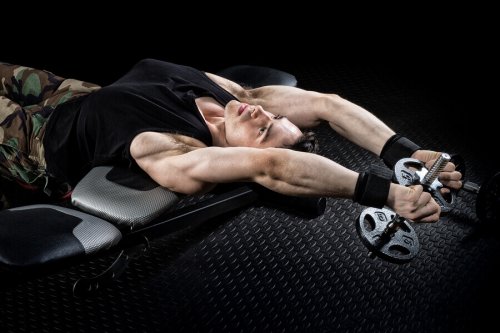What Is an Upper/Lower Split Routine?

The upper/lower split routine is a training method that alternates between two days of lower body workouts and two upper body workouts independently. This differs from traditional routines, which only exercise one muscle group during each fitness session.
Another thing you should know about this routine is that we can customize it according to the needs of each athlete. Thus, even people who are just getting started can carry it out.
While it’s true that most routines have little room for modifications, you can modify and adapt the upper/lower split routine to your liking.
Additionally, you shouldn’t repeat the training more than four times a week since you have to respect the resting days to achieve muscle growth. In fact, muscles need between 48 and 72 hours of rest after intense training. Overtraining can have negative consequences.
Two days for the upper/lower split routine
As we’ve pointed out, the upper/lower split routine consists of alternating two days of the upper body and two days of the lower body in the training plan. Both days entail different ranges of basic strength exercises. The most important factor is the progress; you have to gradually increase the weight load week after week.
It’s an ideal method for athletes who seek to achieve volume or definition. The training sessions should include basic exercises such as squats, deadlift, bench press, or military press.
As for the duration, the sessions shouldn’t last more than one hour (including the warmup) and maintaining the resting periods between sets. Likewise, it shouldn’t take too long to change from one exercise to another.

The weight load of each exercise should be adjusted to the repetitions you have to do. Remember, it’s necessary to progress gradually in terms of intensity. Also, bear in mind the danger of training too much.
One of the most positive aspects of this type of routine is that muscle recovery is optimal since there’s plenty of rest time between training sessions of the same muscle group. This allows you to prioritize the muscles you want to work on each day to improve the results.
Adapt the upper/lower split routing to your training goals
The main advantage is that the upper/lower split routine will allow you to lift more weight and rest more so the muscles recover and grow. Another benefit is that it allows you to adapt your training routine to the goals you want to achieve.
For instance, if your goal is to gain muscle mass, you can organize your routine so that you dedicate half of the weekly session to training with resistance exercises. Meanwhile, you can use the other half to stimulate hypertrophy.
In the days of hypertrophy, two exercises are usually ideal for large muscles and one for the small ones. Therefore, when we do resistance exercises, two of them will be for large muscles and none for the small muscles.
As you can imagine, the number of sets and repetitions will vary depending on whether you’re strength training (two to five sets per exercise) or doing a hypertrophy workout (three to four sets).
Example of an upper/lower split routine
Up next, we’ll show you some examples of exercises to make sure you know what an upper/lower split routine should look like. Take note and include them in your workouts!
Monday: upper body workout
- Warm up: low intensity running.
- Inclined bench press.
- Rowing on a low pulley.
- Military press.
- Pullover.
- Low pulley extensions.
- Biceps + triceps in Z bar.

Tuesday: lower body workout
- Warm up: low intensity running on elliptical.
- Squats.
- Deadlift.
- Lunges.
- Hip Thrust.
Wednesday: rest
Thursday: upper body workout
- Warm up: low intensity running.
- Flat bench press.
- Tricep extension with a dumbbell.
- Bicep curl with a straight bar.
- Arnold Press.
- Pull-ups.
- Push-ups.
Friday: lower body workout
- Warm up on the elliptical.
- Squats.
- Leg press.
- Leg curl.
- Quadriceps extensions.
- Calf raises.

Saturday and Sunday: rest
Lastly, remember that the upper/lower split routine is only one way to distribute our complete body training into two different types of sessions; according to the muscle groups involved.
As always, keep in mind that you shouldn’t overlook the need to eat and rest properly in addition to following the training routine that corresponds to your preparation.
The upper/lower split routine is a training method that alternates between two days of lower body workouts and two upper body workouts independently. This differs from traditional routines, which only exercise one muscle group during each fitness session.
Another thing you should know about this routine is that we can customize it according to the needs of each athlete. Thus, even people who are just getting started can carry it out.
While it’s true that most routines have little room for modifications, you can modify and adapt the upper/lower split routine to your liking.
Additionally, you shouldn’t repeat the training more than four times a week since you have to respect the resting days to achieve muscle growth. In fact, muscles need between 48 and 72 hours of rest after intense training. Overtraining can have negative consequences.
Two days for the upper/lower split routine
As we’ve pointed out, the upper/lower split routine consists of alternating two days of the upper body and two days of the lower body in the training plan. Both days entail different ranges of basic strength exercises. The most important factor is the progress; you have to gradually increase the weight load week after week.
It’s an ideal method for athletes who seek to achieve volume or definition. The training sessions should include basic exercises such as squats, deadlift, bench press, or military press.
As for the duration, the sessions shouldn’t last more than one hour (including the warmup) and maintaining the resting periods between sets. Likewise, it shouldn’t take too long to change from one exercise to another.

The weight load of each exercise should be adjusted to the repetitions you have to do. Remember, it’s necessary to progress gradually in terms of intensity. Also, bear in mind the danger of training too much.
One of the most positive aspects of this type of routine is that muscle recovery is optimal since there’s plenty of rest time between training sessions of the same muscle group. This allows you to prioritize the muscles you want to work on each day to improve the results.
Adapt the upper/lower split routing to your training goals
The main advantage is that the upper/lower split routine will allow you to lift more weight and rest more so the muscles recover and grow. Another benefit is that it allows you to adapt your training routine to the goals you want to achieve.
For instance, if your goal is to gain muscle mass, you can organize your routine so that you dedicate half of the weekly session to training with resistance exercises. Meanwhile, you can use the other half to stimulate hypertrophy.
In the days of hypertrophy, two exercises are usually ideal for large muscles and one for the small ones. Therefore, when we do resistance exercises, two of them will be for large muscles and none for the small muscles.
As you can imagine, the number of sets and repetitions will vary depending on whether you’re strength training (two to five sets per exercise) or doing a hypertrophy workout (three to four sets).
Example of an upper/lower split routine
Up next, we’ll show you some examples of exercises to make sure you know what an upper/lower split routine should look like. Take note and include them in your workouts!
Monday: upper body workout
- Warm up: low intensity running.
- Inclined bench press.
- Rowing on a low pulley.
- Military press.
- Pullover.
- Low pulley extensions.
- Biceps + triceps in Z bar.

Tuesday: lower body workout
- Warm up: low intensity running on elliptical.
- Squats.
- Deadlift.
- Lunges.
- Hip Thrust.
Wednesday: rest
Thursday: upper body workout
- Warm up: low intensity running.
- Flat bench press.
- Tricep extension with a dumbbell.
- Bicep curl with a straight bar.
- Arnold Press.
- Pull-ups.
- Push-ups.
Friday: lower body workout
- Warm up on the elliptical.
- Squats.
- Leg press.
- Leg curl.
- Quadriceps extensions.
- Calf raises.

Saturday and Sunday: rest
Lastly, remember that the upper/lower split routine is only one way to distribute our complete body training into two different types of sessions; according to the muscle groups involved.
As always, keep in mind that you shouldn’t overlook the need to eat and rest properly in addition to following the training routine that corresponds to your preparation.
All cited sources were thoroughly reviewed by our team to ensure their quality, reliability, currency, and validity. The bibliography of this article was considered reliable and of academic or scientific accuracy.
-
Kwakkel, G., Wagenaar, R. C., Twisk, J. W. R., Lankhorst, G. J., & Koetsier, J. C. (1999). Intensity of leg and arm training after primary middle-cerebral-artery stroke: A randomised trial. Lancet, 354(9174), 191–196. https://doi.org/10.1016/S0140-6736(98)09477-X
This text is provided for informational purposes only and does not replace consultation with a professional. If in doubt, consult your specialist.








